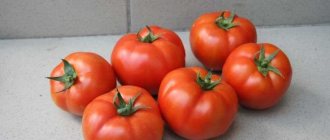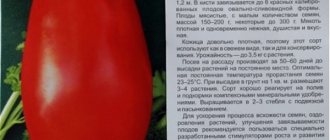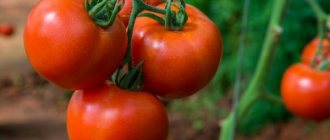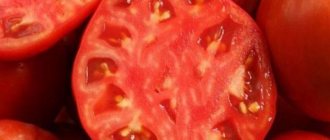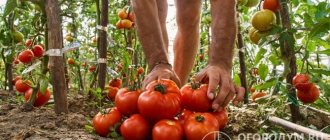Description of the variety
The plant is indeterminate, non-standard, reaches 2 m in height, and therefore requires staking and pinching. Tomatoes are disease resistant. Potato type leaf. The variety is mid-season (up to 180 days), yield is up to 9 kg per bush.
The tomatoes are large, flat-round, yellow-pink-orange when ripe, sometimes pink in color with yellow washes. The weight of the fruit is 300-500 g, but some specimens reach 1 kg or even more. When cut, the tomato flesh is yellow with pink stripes. The dry matter content is high, there are no chambers, and there are very few seeds. The taste is excellent: rich and sweet. Stored well.
Salad variety. The fruits are not suitable for whole-fruit canning, but are good for making sauces.
Variety - “GRAPEFRUIT”. Tomatoes from Fedor.
Description of the Grapefruit tomato, hardening and fruit care
Many gardeners are interested in how to grow Grapefruit tomatoes. Today the characteristics and description of the variety will be presented. The Grapefruit tomato hybrid was developed quite recently, so it has not yet been fully studied and included in the state register of the Russian Federation.
Fruit characteristics
Characteristics and general description of the Grapefruit variety:
- The bushes are indeterminate and are not limited in growth when shoots appear. The height of the bushes reaches 1.5–2 m.
- Late-ripening tomatoes: fruit ripening period is approximately 180 days from the date of planting the seeds.
- The leaves are similar to potatoes, fluffy on one side, bright green in color, with a corresponding smell.
- The rootstock and stems are very strong and can form 2 bushes or more.
- There is immunity to many fungal and viral diseases, but for the purpose of prevention, the bushes should be treated with copper sulfate or a weak solution of potassium permanganate, that is, potassium permanganate.
- In a greenhouse, this variety can grow all year round. It is grown in the ground and outdoors only in summer.
- The yield is average; from 1 plant you can collect up to 15 fruits over the entire season.
Let's take a closer look at the characteristics of tomatoes.
An unripe tomato has a light green color. By the time of full maturity, the skin becomes red with yellow specks, or vice versa.
When cut, the tomato has a bright pink color, which is reminiscent of the fruit of the same name. There are no chambers, a small number of seeds.
The shape of Grapefruit tomatoes is round, flattened at the “poles”. The stalk has a small green spot, but this does not indicate that the fruit is unripe.
The average weight of 1 vegetable is 600-700 g, but many fruits weigh more than 1 kg. The skin is durable and does not crack in the sun or during transportation.
In everyday life, they are used fresh, for salads, lecho, and canning. But in the latter case, the tomatoes have to be cut into several parts due to their large size.
But this variety is not suitable for tomato juice lovers. Due to the large mass fraction of dry matter and high fleshiness, the fruits do not produce much juice.
How to grow seedlings
There are a huge number of methods for growing seedlings, and each vegetable grower chooses his own, proven over the years. However, new technologies are emerging that may be of interest to gardeners. For example, the method of cropping the tops, or the Chinese method of growing seedlings, or rather, propagating. It is most suitable for tall tomatoes such as Grapefruit.
Advantages of the method:
- plants get sick less;
- bushes are stockier and more branched;
- higher productivity;
- increased resistance to stress;
- they take root better after being planted in a permanent place.
Seed preparation
Seeds are prepared for sowing in the traditional way. First, the largest ones are selected, then they are disinfected in a solution of brilliant green, without diluting, for 30 minutes, followed by washing and drying.
Container and soil
It is recommended to take containers for growing seedlings of sufficient volume and a height of approximately 10 cm for the successful development of the root system. If there are no holes in the containers, they must be made, for example, with a hot awl.
Soil for seedlings is most often purchased in supermarkets. It’s a good idea to add agroperlite to the soil. It takes away excess moisture in case of overflow and releases it in case of deficiency.
Sowing
The seeds are laid out on slightly compacted and moistened soil, spilled with a Fitosporin solution. Then sprinkle with a layer of soil no more than 1 cm high and spray with water from a spray bottle.
Growing and care
A month after sowing, at the stage of 2-3 leaves, an “operation” is carried out - cutting off the tops. The day before, the plants are watered abundantly.
The procedure consists of cutting off the above-ground part of the plant below the cotyledons and immediately placing it in an aqueous solution of Epin.
Next, the plants are transplanted into cups with soil and covered with a glass cap or plastic bag. This creates a greenhouse effect and improves rooting. After a few days, the plastic bag is removed and the plants are placed in a sunny place.
Important! In this case, the survival rate of tomatoes is not 100%; some plants (20-30%) may die for beginning gardeners. Therefore, it is advisable to calculate possible losses when sowing.
How to grow tomatoes
Planting seedlings in open ground is carried out when the danger of return frosts has passed, and in closed ground - 1-2 weeks earlier.
Landing
It is recommended to grow the Grapefruit tomato in closed ground (a greenhouse or greenhouse), although in open ground, as many vegetable growers testify, it gives a good harvest.
The soil is watered with a Fitosporin solution two weeks before planting.
The distance between plants is maintained at 0.5 m from each other and 0.4 m between rows.
Add ½ humus, 1 tbsp to the holes for seedlings. spoon of potassium sulfate, 1 tbsp. a spoonful of superphosphate, 1 glass of ash, 1 tbsp. spoon of fish meal and mix.
Plants are placed in prepared holes, oriented from north to south, covered with soil and watered.
After 10 days, the plants are watered with a yeast solution (100 g of yeast per 10 liters of water) so that the seedlings grow well and do not stretch.
Care
Tomatoes do not like frequent watering. If it is not very hot, watering them once a week is enough.
Feeding with mullein and mineral fertilizers is required, which is carried out three times per season.
Foliar feeding is very good for development: iodine, manganese, boric acid, Epin, Zircon, Fitosporin, NV-101. Spraying is carried out every 10 days.
In hot weather, tomatoes are sprayed with a solution of boric acid or “HB-101” (preferably “HB-101”, since if there is an error in diluting boric acid, the plants are damaged).
During the flowering of the third cluster, the plants are fed with a calcium solution in a ratio of 1 tbsp. spoon per 10 liters of water.
Be sure to mulch the soil with grass or hay. The thickness of the mulch layer is 8 cm.
Features and possible difficulties
Grapefruit tomato requires the formation of 2-3 stems and a garter. As vegetable growers note, this variety is very light-loving and does not tolerate the slightest shade.
How to form a tomato bush? The first stepson is left below the first brush, on the left is the main stem, on the right is the stepson - the second stem, and the stepson below the first stepson is the third stem. The remaining stepsons are removed.
Particular attention should be paid to the prevention of late blight, since Grapefruit fruits begin to ripen in late August - early September. To do this, it is necessary to improve the ventilation and illumination of the plants: when tomatoes the size of a nut are tied to the brush, all the leaves under the brush are removed.
Attention! You can’t cut too many leaves at once, about two leaves a week!
Diseases and pests
Grapefruit is a disease-resistant tomato variety, but to prevent the plants from getting late blight, the most common disease of tomatoes, the bushes are sprayed with solutions of Trichodermin and Fitosporin every two weeks.
The most common pest of tomatoes is the whitefly. The biological method of combating it is the settlement of a parasitoid wasp, Encarsia formosa, every two weeks in the form of infected puparia.
Spraying with Fitoverma solution helps well against other insect pests.
Secrets of cultivation
You can grow grapefruit tomatoes in absolutely any region of Russia. However, for successful ripening in some parts of the country it is necessary to use a greenhouse. It is better to start preparing seeds for seedlings in the first half of spring; to do this, you need to soak them in water for a day. By the way, you can add a small amount of a growth stimulator to the water. After this, they can be sown in prepared containers; “grapefruit” is not picky about soil. When the first grains germinate, they begin to sprout, a third leaf forms on them, and it’s time to pick. In order for plants to quickly adapt to climatic conditions, it is recommended to harden them.
The nuances of growing in open ground and greenhouses
It is recommended to grow the Grapefruit tomato in a greenhouse primarily due to the late ripening of the fruit.
It is known that in a greenhouse, tomatoes often suffer from extreme heat, but at temperatures above 40°C, tomato flowers are sterilized, therefore, ovaries do not form.
To reduce the temperature in the greenhouse, the roof is covered with lutrasil, and the doors and windows are also opened.
When watering tomatoes in a greenhouse, adhere to the following rules:
- water for irrigation should be at a temperature of 20-22°C;
- water at the root without touching the leaves;
- water in the morning, since during evening watering condensation forms, which favors the proliferation of pests and diseases.
Of course, on the one hand, it is better to grow tomatoes in a greenhouse. But on the other hand, varieties for closed ground cause more trouble and do not produce such a bountiful harvest as for open ground. Don’t chase the best varieties, experiment and choose ones that suit your weather conditions. If the climate of the region allows, the Grapefruit variety can be grown in open ground. With this method, the main thing is to choose the right landing site. This should be a sunny place without stagnant water, preferably where radishes, carrots, beets, cabbage, legumes or lettuce previously grew.
The soil in open ground is fertilized in the same way as in a greenhouse.
Diseases and pests
One of the most common problems faced by both experienced and novice gardeners is pests. Grapefruit tomatoes are no exception. Despite the fact that they are quite resistant to diseases and insects, preventive measures should not be abandoned.
The first thing you should pay attention to is the fight against late blight. The disease is characterized by the appearance of brown spots on leaves and fruits, which have different shapes. At the same time, the inside of the leaves becomes covered with a light white coating. In order to prevent the “grapefruit” from becoming infected with late blight, it should be planted as far as possible from the potatoes, and fertilizing should be applied, which includes phosphorus and potassium. 20 days after planting plants in open ground or in a greenhouse, they must be sprayed with the Zaslon preparation. In another week it’s worth using the “Barrier”. Afterwards, throughout the summer, you can use an eco-solution made from water, milk and a few drops of iodine. In order to fight the mole cricket, which eats up the roots of vegetables, the drug “Thunder” is suitable. If we talk about folk remedies, then you can use a tincture of hot pepper or a vinegar solution for “grapefruit”.
Advantages and disadvantages of the variety
The advantages of the Grapefruit tomato include:
- amazing taste;
- rich aroma;
- unusual appearance and colors;
- good keeping quality;
- resistance to many diseases and pests;
- productivity;
The disadvantages are the need for garter and late ripening.
Farmer reviews
Vegetable growers unanimously admire the taste and beauty of the Grapefruit tomato.
Nadezhda, Kaluga region: “My Grapefruit is seeds from Redko.
Indeterminate, has grown to 1.5 m. Very tasty, but the yield is low, I will repeat and tame.” Ekaterina, Orsha: “Very productive - I’m surprised. It turns out about 5 kg per bush - for me this is a lot. The bush is powerful, initially it had two stems, now it seems to be growing into four. Late, the fruits are large, sour, juicy. I repeated it from my seeds and realized that this variety does not tolerate the slightest shade - it grew in the middle of the central ridge. The yield and size of the fruits are significantly lower than last year (then tomatoes grew right next to the entrance).”
Vitana, Izhevsk: “In 2015, I planted Grapefruit for the first time. In the greenhouse it turned out to be one of the largest, although it was a little late and did not have time to show itself in all its glory. I liked both the taste and the size! This year, Grapefruit surprised and delighted me even more. Its fruits were the largest. The best harvest was on a bush that grew freely in a grape greenhouse. It grew into two stems and was about 2 m high. The tomatoes on the upper clusters were even larger than those on the lower ones. I harvested the last fruits in October, and recently ate the last one. The taste is very good! And handsome."





